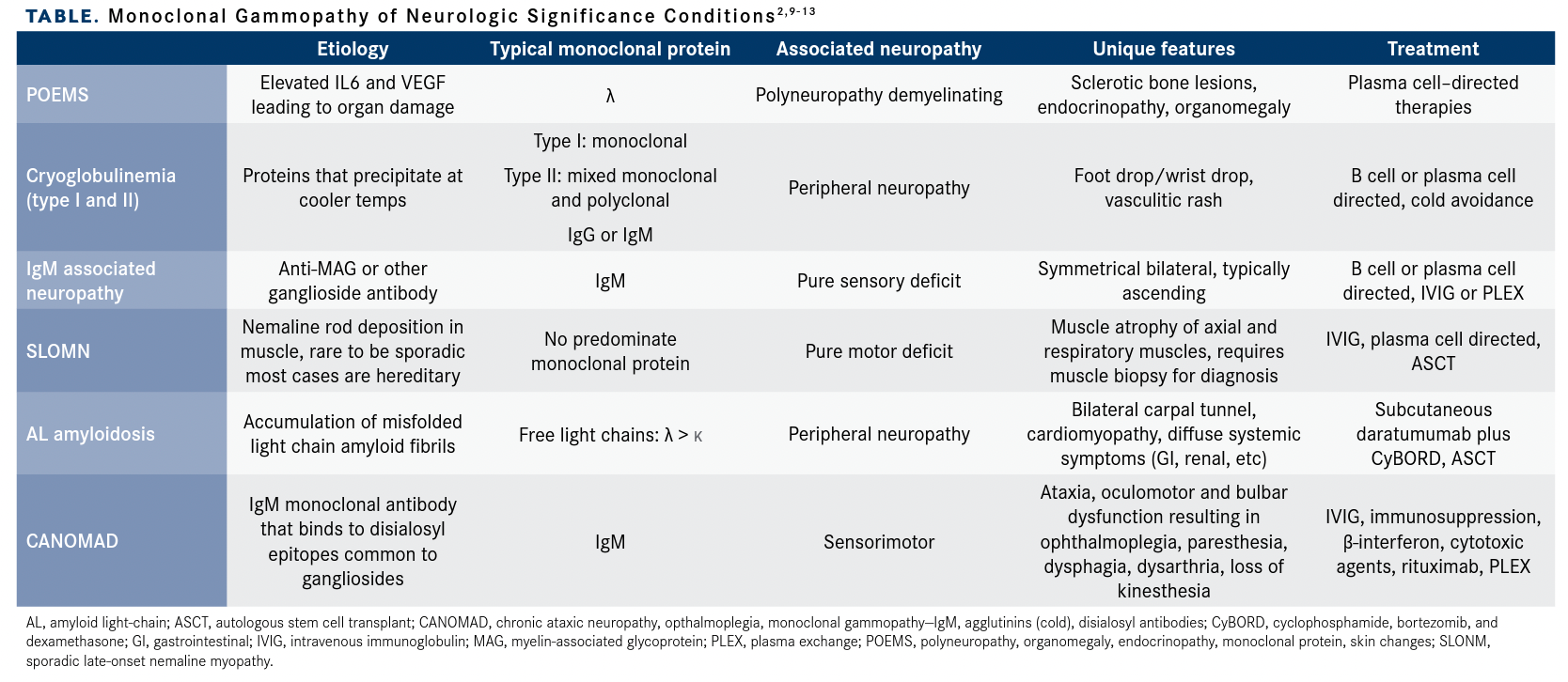Publication
Article
Cracking the “MGUS” Code Reveals Monoclonal Gammopathy of Clinical Significance:
Author(s):
When assessing monoclonal gammopathy it is important to rule out clinically significant associations requiring treatment.
Sandra Mazzoni, DO

When assessing monoclonal gammopathy it is important to rule out clinically significant associations requiring treatment. On initial patient consultation, gathering a detailed patient history and thorough physical exam can catch clinically significant pearls to guide next diagnostic steps. It is critical to recall that monoclonal proteins can be produced by both plasma cells and B cells, and identifying the source will determine the treatment in many cases. A referral to a center with multidisciplinary care is best practice to ensure appropriate workup in a timely manner.
There are recognized monoclonal gammopathies of dermatologic, neurologic, renal, skeletal, and hematologic significance.
Monoclonal Gammopathy of Dermatologic Significance (MGDS)
There are a variety of skin manifestations driven by either clonal B cell or plasma cell protein production and associated alteration of the immune system. Referral to a dermatology department for skin biopsy is essential in most cases.1
Cryoglobulin Vasculitis
Cryoglobulins are immunoglobulins in the serum that precipitate as temperatures cool from core body temperature in the extremities. Type I (monoclonal) and type II (mixed with a monoclonal component) are associated with monoclonal gammopathy. The skin manifestations typically affect the extremities and can include petechiae and purpura, Raynaud phenomenon, skin necrosis, and ulcers. Treatment is either targeted to B cells or plasma cells depending on what is driving the monoclonal protein.2
Scleromyxedema
This is a condition associated most with IgGλ monoclonal gammopathy. It is a distinct disorder and not associated with thyroid myxedema or scleroderma. Skin lesions are waxy, firm plaques or papules with biopsy showing mucin deposition and fibroblast proliferation.
This is often a systemic process leading to heart block, cardiomyopathy, dysphagia due to esophageal dysmotility, hoarseness, restrictive lung disease, acute renal failure, and carpal tunnel. This is treated with systemic plasma celldirected therapy with immunomodulatory drugs (IMiDs) and steroids. There is a role for proteasome inhibitors and autologous stem cell transplant in IMiD-refractory cases.3
Dermato-neuro syndrome can develop which is associated with significant morbidity and mortality. It is manifested by memory loss, vertigo, gait disturbance, stroke, seizures, and psychosis. It is typically preceded by malaise with fever. Treatment consists of steroids, intravenous immunoglobulin (IVIG), and plasmapheresis (plasma exchange; PLEX).4
TEMPI
TEMPI—or telangiectasias, erythrocytosis with elevated erythropoietin (EPO) level, monoclonal gammopathy, perinephric-fluid collections, and intrapulmonary shunting—has an unclear mechanism. Hallmarks include markedly elevated EPO levels with erythrocytosis in the absence of a JAK2 mutation. These patients respond well to plasma cell–directed therapies.5
Schnitzler Syndrome
This urticarial rash is driven by increased IL1. It is typically seen with IgM monoclonal gammopathy with systemic symptoms that include fever, arthritis, arthralgia, bone pain, lymphadenopathy, and hepatosplenomegaly. The disease has an indolent course with a low-risk of progression to Waldenström or B-cell lymphoma. The rash is treated with IL1 inhibitors.6
Sweet Syndrome
Also known as acute febrile neutrophilic dermatosis, the erythematous annular skin rash can be quite painful and is often associated with fever. Skin punch biopsy reveals neutrophilic infiltrate into the dermis. Treatment of the rash is a combination of steroids and therapy targeted at either the B cell or plasma cell clone producing the monoclonal protein.7
Pyoderma Gangrenosum
Most often associated with inflammatory bowel disease and arthritis, pyoderma gangrenosum has been reported in up to 20% of cases of IgA monoclonal gammopathy. These cases can progress to multiple myeloma, so patients should receive plasma cell–directed therapy. Unfortunately, these patients often prove to be refractory to treatment.8
Monoclonal Gammopathy of Neurologic Significance (MGNS)
There exists a wide range of monoclonal protein–driven neurologic conditions. Presenting symptoms may include myopathy, neuropathy (sensory and/or motor), muscle atrophy, and ataxia. These cases should be assessed by both a hematologist and a neurologist. Typical workup includes a thorough neurologic assessment with electromyography and additional studies such as imaging, biopsy, and laboratory tests. A bone marrow biopsy is essential in these cases for both diagnosis and to guide treatment.
MGNS conditions are compared in the TABLE2,9-13 including the following:
- POEMS (polyneuropathy, organomegaly, endocrinopathy, monoclonal protein, skin changes)9
- Cryoglobulinemia (type I and II)2
- IgM-associated neuropathy10
- SLONM (sporadic late-onset nemaline myopathy)11
- Amyloid light-chain (AL) amyloidosis12
- CANOMAD (chronic, ataxic, neuropathy, ophthalmoplegia, monoclonal gammopathy—IgM, agglutinins [cold], and disialosyl antibodies)13
TABLE. Monoclonal Gammopathy of Neurologic Significance Conditions

Monoclonal Gammopathy of Renal Significance (MGRS)
Monoclonal gammopathy in the setting of unexplained proteinuria and/or declining renal function requires renal biopsy for diagnosis. It is important to elicit the source of monoclonal protein production by obtaining a bone marrow biopsy and advanced imaging as these can be either plasma cell or B-cell clones.
Treatment is focused on targeting the clonal cells to stop the monoclonal protein production with the goal of preserving renal function. Twenty-four-hour urine studies are helpful to monitor response to treatment. The mechanism of injury determines the site of renal damage. Additional immunofluorescent stains can identify the monoclonal proteins within the renal biopsy. They are as follows14:
- Glomeruli only:
- Proliferative glomerulonephritis with monoclonal immunoglobulin deposits
- Immunotactoid glomerulonephritis
- C3 glomerulopathy
- Proximal tubules only:
- Light chain proximal tubulopathy
- Glomeruli plus vessels:
- Cryoglobulinemic glomerulonephritis (type I and II cryoglobulins only)
- Atypical hemolytic uremic syndrome
- POEMS glomerular microangiopathy— cytokine-induced endothelial injury
- Distal tubules
- Cast nephropathy
- All renal compartments:
- Monoclonal immunoglobulin deposition disease
- Light chain and or heavy chain
- AL amyloidosis
Monoclonal Gammopathy of Skelatal Significance
There is more evidence emerging regarding an association between monoclonal gammopathy and skeletal changes. With POEMS it is common to see sclerotic bone lesions. In acquired Fanconi syndrome osteomalacia can develop because of hypophosphatemia. The International Myeloma Working Group recommends bisphosphonate use in all cases of monoclonal gammopathy with osteopenia or osteoporosis. The purposed mechanism driving increased bone turnover is an increase in cytokines CCL3/ MIP-1α (osteoclast-activating factor) and DKK1 (osteoblast-suppressive factor).15
Monoclonal Gammopathy of Hematologic Significance
Even small plasma cell or B-cell clones can alter the bone marrow environment and immune response leading to different acquired hematologic disorders. These include acquired pure red cell aplasia, acquired von Willebrand syndrome, (AVWS), cold agglutinin disease, and other rare, acquired bleeding disorders. These are complex conditions that warrant involvement of benign hematology experts.
The mechanism of acquired pure red cell aplasia associated with monoclonal gammopathy is due to an antibody or effector T lymphocytes targeting an erythroid precursor, leading to arrest of erythropoiesis.
Treatment is a combination of plasma celldirected therapy and immunosuppression. Cyclosporine with or without steroids is the most used immunosuppression regimen. There is evidence for the use of eltrombopag plus immunosuppression in refractory cases.16
Anti–von Willebrand factor (VWF) antibodies lead to a reduction of VWF in monoclonal gammopathy-driven AVWS. These patients can have significant bleeding phenotypes. It is important to treat the underlying clonal disorder, provide replacement VWF with either DDAVP or recombinant VWF and reduce the anti-VWf antibodies with either IVIG or PLEX.
An acquired factor X deficiency can be seen with amyloidosis. This occurs because both factor X and pentraxin-2 (PTX-2) bind to amyloid fibrils. PTX-2 binds to factor X to form a complex with scavenger receptor class A member I, which protects factor X from macrophage clearance. When PTX-2 levels decrease there is increased macrophage clearance of factor X.17
Other reported acquired bleeding conditions seen with monoclonal gammopathy driven by auto-antibody formation include Bernard-Soulier with anti-GPIb/IX/V, Glanzmann thrombasthenia with anti-GPIIb/IIIa, and antifibrin antibodies leading to dysfibrinogenemia and hypofibrinogenemia.18 IgM Hyper-viscosity is also a known cause of bleeding diathesis.
References
- Claveau JS, Wetter DA, Kumar S. Cutaneous manifestations of monoclonal gammopathy. Blood Cancer J. 2022;12(4):58. doi:10.1038/s41408-022-00661
- Muchtar E, Magen H, Gertz MA. How I treat cryoglobulinemia. Blood. 2017;129(3):289-298. doi:10.1182/blood-2016-09-719773
- Lacy MQ, Hogan WJ, Gertz MA, et al. Successful treatment of scleromyxedema with autologous peripheral blood stem cell transplantation. Arch Dermatol. 2005;141(10):1277-1282. doi:10.1001/archderm.141.10.1277
- Larios JM, Ciuro J, Varghese TS, Lyons SE. Successful treatment of dermato-neuro syndrome with plasmapheresis. BMJ Case Rep. 2020;13(12):e237170. doi:10.1136/bcr-2020-237170
- Sykes DB, O’Connell C, Schroyens W. The TEMPI syndrome. Blood. 2020;135(15):1199-1203. doi:10.1182/blood.201900421
- Simon A, Asli B, Braun-Falco M, De Koning H, et al. Schnitzler’s syndrome: diagnosis, treatment, and follow-up. Allergy. 2013;68(5):562-568. doi:10.1111/all.12129
- Kechaou I, Cherif E, Boukhris I, Azzabi S, Hassine LB. Syndrome de Sweet récidivantcompliqué de gammapathiemonoclonale de signification indéterminée.Abstract in English. Rev Med Brux. 2017;38(3):152-153.
- Machan A, Azendour H, Frikh R, Hjira N, Boui M. The dilemma of treating pyoderma gangrenosum associated with monoclonal gammopathy of undetermined significance. Dermatol Online J. 2020;26(5):13030/qt1bk7d8hj. doi:10.5070/D3265048791
- Khouri J, Nakashima M, Wong S. Update on the diagnosis and treatment of POEMS (polyneuropathy, organomegaly, endocrinopathy, monoclonal gammopathy, and skin changes) syndrome: a review.JAMA Oncol. 2021;7(9):1383-1391. doi:10.1001/jamaoncol.2021.0586
- Chen LY, Keddie S, Lunn MP, et al. IgM paraprotein-associated peripheral neuropathy: small CD20-positive B-cell clones may predict a monoclonal gammopathy of neurological significance and rituximab responsiveness. Br J Haematol. 2020;188(4):511-515. doi:10.1111/bjh.16210
- Schnitzler LJ, Schreckenbach T, Nadaj-Pakleza A, et al. Sporadic late-onset nemaline myopathy: clinico-pathological characteristics and review of 76 cases. Orphanet J Rare Dis. 2017;12(1):86. doi:10.1186/s13023-017-0640-2
- Palladini G, Merlini G. How I treat AL amyloidosis. Blood. 2022;139(19):2918-2930. doi:10.1182/blood.20200008737
- Le Cann M, Bouhour F, Viala K, et al. CANOMAD: a neurological monoclonal gammopathy of clinical significance that benefits from B-cell-targeted therapies. Blood. 2020;136(21):2428-2436. doi:10.1182/blood.20200007092
- Leung N, Bridoux F, Batuman V, et al. The evaluation of monoclonal gammopathy of renal significance: a consensus report of the International Kidney and Monoclonal Gammopathy Research Group. Nat Rev Nephrol. 2019;15(1):45-59. Published correction appears in Nat Rev Nephrol. 2019;15(2):121.
- Drake MT. Unveiling skeletal fragility in patients diagnosed with MGUS: no longer a condition of undetermined significance? J Bone Miner Res. 2014;29(12):2529-2533. doi:10.1002/jbmr.2387
- Huang Y, Jiang X, Han B. Effective treatment of refractory acquired pure red blood cell aplasia with eltrombopag and sirolimus: a case report. Ther Adv Hematol. 2020;11:2040620720940144. doi:10.1177/2040620720940144
- Muczynski V, Aymé G, Regnault V, et al. Complex formation with pentraxin-2 regulates factor X plasma levels and macrophage interactions. Blood. 2017;129(17):2443-2454.doi:10.1182/blood-2016-06-724351
- Dear A, Brennan SO, Sheat MJ, Faed JM, George PM. Acquired dysfibrinogenemia caused by monoclonal production of immunoglobulin lambda light chain. Haematologica. 2007;92(11):e111-e117. Doi:10.3324/haematol.11837










